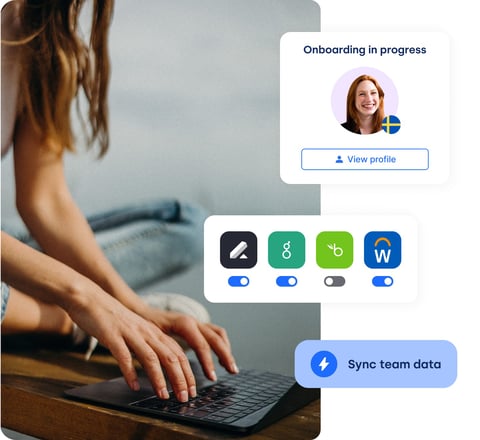
Your Ultimate 2024 Guide On Hiring And Managing Remote Workers

Key takeaways
- Managing a fully remote team differs from managing a team on-site and calls for new rules and processes documented in a remote work policy.
- Companies that hire remote teams experience easier global expansion, save money on office space, and have a happier and more productive workforce.
- A key task for a remote team manager is to facilitate interpersonal connections and communication among team members and ensure team wellbeing while helping the workers avoid burnout.
Despite many companies requiring their workers to return to the office, it doesn’t seem that remote work is going anywhere. Around 35% of workers across industries in the US have the option to work remotely every day of the week. According to Forbes, remote workers with flexible schedules are generally more productive than employees working 9-5 from centralized offices, and around 20% happier.
Remote work isn’t necessarily a simple switch from traditional work. Remote management differs significantly from traditional team management, requiring new communication styles, technology, and processes.
In our ultimate guide on remote teams, you’ll learn about remote work’s pros and cons and strategies to hire and manage remote teams.
What is a remote team?
A remote team comprises employees and independent contractors working from different locations. They can spread across cities, states, countries, and different time zones.
Remote teams, also called distributed teams, are not a novelty. However, the transition from on-premise to cloud-based technology and the development of remote collaboration tools enabled companies to easily hire teams from around the globe.
Did you know?
We speak from experience: Deel has a team of 2,000+ people distributed in over 80 countries.
Are remote-friendly and remote-first the same?
Although sometimes they’re used interchangeably, the terms remote-friendly and remote-first don’t mean the same.
Remote-first companies let employees work from home without any sort of regular commute to an office. These companies set up systems and processes from scratch to cater entirely to a solid work-from-home experience. They might have quarterly or annual on-sites where remote candidates gather from their respective home offices (across the globe) to collaborate in person.
On the other hand, remote-friendly companies allow employees to work from home some or most of the time but require occasional in-person attendance. These are also called hybrid teams and must set up in-person and remote work processes and hybrid policies to produce equality between at-home and in-office work.
Learn more about the difference between remote-first and remote-friendly teams.
Benefits of remote teams
A remote team is only as great as its culture, processes, and leadership. The best remote teams enjoy the following advantages.
Happier and more productive remote employees
The primary benefit of remote teams is the opportunity for truly flexible work. Team members who work from home (or other non-office locations) ditch commuting and, often, rigid schedules altogether.
Remote workers may sometimes have specific schedules or shifts, especially if they work in customer service. But many remote workers can work flexible hours and build their workday around their life—not the other way around. This allows for a better work-life balance and a happier, more productive workforce.
Matt Monette, UK&I Country Lead, Deel
Access to a wider pool of top talent
Remote work lets you hire the best talent, not the nearest. Many remote businesses hire from anywhere in their country—or even the world—to access the very best talent. Most companies can also find skilled workers from companies with lower costs of living to hire the talent they couldn’t afford in more expensive areas.
Saving costs on physical offices
Many companies with remote workforces ditch any sort of working space, saving thousands (or tens of thousands) of dollars each month on the cost of renting and maintaining a physical office.
When companies take this route, they can afford to offer remote team members additional benefits like work-from-home-stipends, money employees use to equip their home offices for work.
Expanding into new regions, languages, and time zones
A remote team—especially a global one—enables you to provide services 24 hours a day in new languages and regions. This is especially helpful for sales and customer service teams, allowing them to build better relationships with clients and customers.
How Sweep secured top global talent and reduced hiring admin with Deel
Sweep is a data-driven platform that helps businesses track and act on their carbon to become more sustainable and stay compliant with climate reporting standards.
Rachel Delacour, CEO and Co-Founder of Sweep, realized long ago that she might not find all of the expert talents she needed in her home country and began to look elsewhere to fill positions, but hiring from abroad was a bureaucratic nightmare. Remote work wasn’t an option at the time, and relocating an employee would be a near-impossible task requiring a lot of energy, time, and money.
Thanks to Deel's solution, Delacour's workforce today scales with the global SaaS potential of Sweep.
"Being able to work remotely with a global team [has] been super transformative for me. My team and any applicant can stay in their home country while enjoying working for Sweep. I’ve been able to hire in London easily, Bulgaria, the United States, and more. Every company and every talent now has the same chance. Everything is possible," says Delacour.
Learn more about Sweep's transformation brought by Deel
Unique challenges of international, remote teams
Hiring remote teams becomes more complicated when including candidates from other countries. Below, we discuss a handful of the major challenges of global hiring.
Compliance with local labor laws
When you hire employees from other countries, you must follow the laws of the employee’s home country, not those of the company’s home country. Truly global companies generate contracts and conduct work compliant with a wide range of labor requirements, like paid time off or tax documentation.
Global payroll and tax compliance
Global payroll is significantly more complex than local payroll—especially if you hire employees from multiple foreign countries. For example, say you hired people from the Netherlands, Colombia, and Nigeria. These countries have different minimum wage laws, available payment methods, tax laws, requirements regarding employee misclassification, and more. Non-compliance penalties are steep, so companies often prefer outsourcing global payroll to save the time, money, and effort of handling it in-house.
Global Payroll Compliance Checklist
Non-compliance with global payroll requirements is not an option for growth-minded companies. The risks are too significant, and international expansion is too important.
We’ve created a global payroll checklist to help companies eliminate compliance risk and implement a global payroll system that is standardized, streamlined, and secure.
Get your free checklist now
How to hire a remote team
In-person and virtual job interviews have the same purpose: to establish whether a candidate and a company are a good fit. However, despite more or less similar approaches, an interview for hiring a remote employee requires you to pay more attention to the tech.
Use remote technology to improve virtual recruiting
A remote interview requires a certain set of interview tools. Chances are, your company used many of these tools because of the sudden transition to remote work during the pandemic. But if not, you’ll need to use certain tools to overcome the lack of face-to-face social interaction, namely Zoom or another video conference tool.
Prepare for technical issues during remote interviews
Your professionalism and the candidate’s first impression depend on a stable internet connection and both parties’ ability to handle unexpected technical glitches and distractions that may arise.
As the interviewer, it’s in your best interest to address any awkwardness by reassuring the candidate that technical issues and distractions are part and parcel of remote interviews and will not inhibit their chances of getting the job. To get around any technical difficulties:
- Send an email to the candidate providing all interview-related information in advance
- Have a backup plan in case technology or internet connection fail
- Start an interview with small-talk
Determine how to pay remote workers
Paying remote workers depends on their classification and location. If your employees reside in the same country or region as your company, paying them is pretty simple since you follow the same process to pay your office-based employees. You should:
- Add the employee to your payroll system
- Pay local contributions
- Deduct relevant taxes from their income
You have three options to pay your international remote team:
Set up a foreign subsidiary and run payroll locally: Opening a foreign subsidiary is a complex process, but it’s the most permanent and encompassing solution for businesses that want to grow into one other country. Once you open the foreign subsidiary, you’ll operate as a fully functioning business in that country and can run domestic payroll for any employees you hire there.
Outsource payroll to an employer of record (EOR): An EOR owns and operates entities in many countries and hires employees on other businesses’ behalf to spare them from having to set up foreign subsidiaries. EOR service providers also maintain payroll records and can pay numerous remote international employees in their local currencies across multiple countries and regions while tracking payroll performance. An EOR is often the preferred option to pay foreign employees since it takes care of all local employment and automates payroll on your behalf while you manage the employee’s schedule and work.
Shannon Karaka, Head of Expansion ANZ, Deel
Hire and pay remote workers as independent contractors: Companies requiring short-term or project-based support may engage independent contractors instead of hiring employees. As the contractor’s client, you do not have to own a business in the worker’s country to hire them legally. You are responsible for paying the invoice in their local currency under the agreed terms and schedule, but not for the accompanying benefits and local taxes. The contractor must pay taxes and arrange benefits themselves. The best tools to pay independent contractors include digital payment platforms, such as PayPal, and prepaid cards like Deel Card.
Note that employees and independent contractors entail different working relationships. Employees must complete work according to the company’s preferences, while contractors have a high degree of control over how, when, and where they work. If you treat a contractor as an employee, you risk misclassification penalties.
12 remote team management tips to build a productive and engaged team
To run a remote team successfully, you must establish clear expectations from the beginning, provide the right tools for collaboration and communication and brief your new remote hires on your remote working policies and processes to ensure they succeed in their role.
1. Reimagine your onboarding process
Effective onboarding is essential for making an excellent first impression, boosting employee retention, and improving the performance of new hires, so they succeed in their role.
In-office onboarding typically begins on the new hires’ first day, with a workspace tour. In a remote work environment, however, the onboarding process is quite different. Companies must help set up the new hire from a distance and recreate these “organic” social scenarios using digital tools and technology.
While online onboarding may seem more forced or unnatural, a satisfying remote onboarding process is possible. Many organizations even find online onboarding is more streamlined and scalable, thanks to the availability of sophisticated onboarding software.
Onboarding by Deel, for example, is an HR plugin designed for distributed teams that helps companies automate online onboarding. The tool builds automated workflows in Slack to take new hires from day one trainees to high performers. It also auto-assigns tasks based on the new hire’s location or department and reduces the manual workload.
Every week, team members receive a message on Slack pairing them with another team member and giving them the option to find a time to meet virtually or in person.

Get an extensive async worker onboarding checklist to streamline your onboarding process.
2. Embrace remote-friendly communication tools and processes
In the remote world, effective communication hinges on virtual leadership skills and the right set of tools.
Remote employees working in various locations and time zones may not be available simultaneously. Therefore, remote teams must embrace both synchronous and asynchronous forms of communication to allow teams to communicate in their own time and in real-time.
The most common examples of remote synchronous communication are:
- Video calls via Zoom or Google Meet
- One-on-one or conference phone calls
- Virtual team meetings and company all-hands on video conferencing platforms like Livestorm
Examples of remote asynchronous communication:
- Pre-recorded video messages (via Loom)
- Notes in project management tools (like Basecamp, Asana, and Trello)
Some tools, like Slack, fuse asynchronous and synchronous communication. Slack calls itself a real-time communication tool because people tend to use Slack messages to chat back-and-forth on the app. But Slack doesn’t require an immediate response, making it async as well.
3. Adopt remote team-building activities
When coworkers don’t spend time in the same workplace and lack face-to-face interaction, it can be challenging to form connections with their colleagues and develop a sense of belonging. You can overcome this by facilitating online social engagement and organizing remote team-building activities. Virtual team-building events can help you build and maintain company culture in distributed teams, strengthen team bonds, and increase employee engagement.
Allow remote teams to create Slack watercooler channels where members can discuss personal interests and encourage workers to take virtual one-on-one coffee breaks to refresh during work hours. Schedule virtual team hangouts where teams can play games and discuss non-work-related topics.
4. Prioritize remote team inclusion
Creating a diverse, equal, and inclusive work environment is just as important for remote teams as for in-office teams. Companies adopting inclusive workplace practices help their remote team members feel like they’re on a level playing field regardless of their background, location, or job title.
Inclusive workplace practices to adopt:
- Create an equality, diversity, and inclusion policy. Share it internally and externally to help your existing remote teams embody these values and attract and welcome new remote workers from diverse backgrounds.
- Promote transparency and honest communication. Create a safe place for remote workers to share their feelings and experiences without judgment or consequences.
- Check your systems and traditions to identify and remove any exclusionary practices and biases. For example, check your hiring process and do away with discriminatory requirements or gender-specific language.
5. Track remote employee performance
Establish processes and systems for measuring remote employee productivity that do not undercut trust or verge on micromanaging. For example, goal setting, weekly one-on-one check-ins, and KPIs are a great way to follow remote employees’ performance while respecting their independence.
However, practices such as time-tracking and computer monitoring software can be invasive and cause unnecessary stress.
Want to hire remote team members?
Deel's in-house experts are ready to help you navigate international hiring, onboarding, payroll, and more. Get a free resource bundle on how to quickly tap into global talent.

6. Help newly remote employees avoid burnout
It’s common for remote workers to form a habit of overlapping work and free time since there are often no set office hours or commutes. This can lead to burnout which impacts productivity at both organizational and personal levels.
To ensure the wellbeing of your team and increase their productivity at home, support your remote employees in maintaining a good work-life balance by educating them on healthy remote working practices and encouraging them to take time to rest and be with their loved ones.
7. Organize remote employee training
Those new to remote work require training and support to help them get set up for success.
In addition to learning all aspects of their role, new remote hires also benefit from training on:
- Cybersecurity
- Effective communication
- Preventing burnout
Once you’ve decided on your training topics, you’ll need to choose how to deliver them. Whether you want to run instructor-led sessions or use e-learning software so new hires can learn at their own pace (or do both!) is up to you.
8. Reduce or eliminate meetings
Do you know that “this meeting could have been an email” feeling? Although many teams hold an old-fashioned belief that team meetings boost productivity, they negatively affect employee efficiency and focus. Once your new employees are fully onboarded, for example, there’s no need for daily check-ins—a weekly meeting will do.
To allow your remote teams time to concentrate on the job at hand, eliminate meetings that:
- Do not have a clear purpose
- Do not have a concrete problem to solve
- Could be communicated asynchronously
Even if you reduce the number of meetings, keep other communication channels open. In a remote work environment, we can’t stop by a coworker’s desk to drop a question, so it’s important for remote employees to know that they can reach out outside of meetings.
9. Create a remote work policy
If you’re adopting the remote work model for the first time, chances are you’re going to create some of the processes from scratch, while others will need to be adapted to the new conditions. Creating a remote work policy will allow you to communicate all the rules and processes instantaneously to everyone in the company and have a source of truth to help you resolve any challenges.
Your remote work policy should be a part of new employee onboarding documentation so the new hire can immediately learn about how different procedures at the company work.
Check out our free, editable remote work policy templates here:
- PTO policy template
- Employee relocation policy template
- Remote employee attendance and time tracking policy template
- Global mandatory benefits policy template
10. Develop your management skills
A significant part of managing remote workers successfully lies in consistent work on your leadership skills.
Almost half of the employees who participated in a Ten Spot survey reported that they’re thinking about quitting their job because of the poor management of their current leader, which goes to show that fostering good relationships with direct reports can make a huge difference.
The same way you organize training for your team, you should also focus on developing your own management style, nurture teamwork and other core values among your team members, celebrate their successes and milestones to boost team morale, and help them develop their careers.
Join our monthly newsletter
The latest insights on today's world of work straight to your inbox.
Thank you for joining!
11. Encourage effective communication
The best way to ensure effective communication among remote teams is to create a guide setting out communication tools and processes that organizations can share during onboarding.
Provide your remote team with the opportunity to feedback on these processes and tools to ensure continual improvement.
12. Invest in tools to improve remote team collaboration
Every organization has unique needs and objectives. However, the tech stack many remote teams use includes:
- Trello
- Asana
- Monday.com
- HubSpot
- Jira
- Slack
- Microsoft Teams
- Basecamp
These tools offer video conferencing, instant messaging, project management, and other features teams need to ensure their tasks are completed as efficiently as possible.
Hire and pay your global virtual team with Deel
Need to hire quickly? With Deel, you can hire talent from countries worldwide in minutes, cost-effectively, and with minimal effort on your end.
The entire employment process gets handled by local hiring experts, so you can focus on building your best business.
Next steps
➡️ Ready to start building a remote team?
Download our Quickstart Resource Bundle to fast-track your company's growth and get expert insights, templates, and guides, all in one place.
🤔 Still thinking?
An international team can facilitate global expansion: read why you should tap into new markets and grow beyond your borders.




